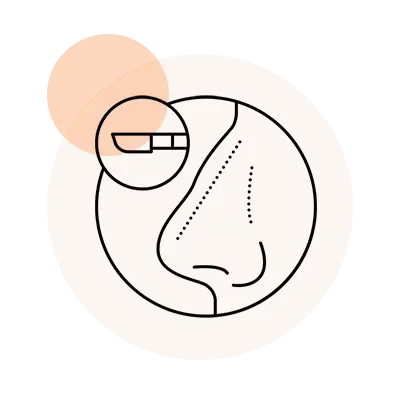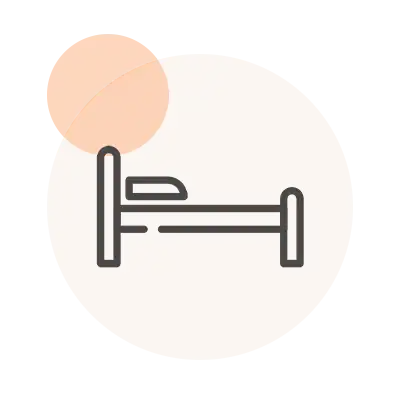Rhinoplasty is a surgical procedure to reshape or repair the nose. Rhinoplasty surgeries may be performed for medical reasons, such as to correct breathing problems, or for cosmetic reasons to enhance the patient’s nose structure and overall facial balance. In most cases, both functional and cosmetic goals can be achieved with a single nose job surgery.
Historically rhinoplasty procedures were performed by a specialist plastic surgeon however the evolution of contemporary techniques has seen nose job operations more commonly performed by surgeons who are specialists in otolaryngology or ENT surgery. The American Academy of Facial Plastic Surgery, the world’s premier professional organisation of surgeons who perform rhinoplasty, has surgeons with ENT training background as the majority of its membership.

Nasal and sinus conditions can have a significant impact on a person’s quality of life and day-to-day functioning. During your initial consultation, your ENT specialist will be able to identify which part of the nose requires attention and if you are a suitable candidate for undergoing rhinoplasty surgery.
Rhinoplasty surgery usually takes between one and three hours, depending on the complexity of the procedure. It can be performed as a day surgery or you may stay overnight in hospital. More than one nasal surgery may be needed in severe cases to achieve the desired outcome.
Rhinoplasty is performed in one of two basic ways: closed technique or open technique. The exact surgical technique your ENT surgeon will use depends on the type of alteration that the nose requires.
The closed rhinoplasty technique does not leave any visible scars on the nose because all of the incisions are made inside the nostrils. The internal incisions allow the surgeon access to bone and cartilage.
Open rhinoplasty involves making a small incision across the columella (the strip of tissue between the nasal openings). This allows direct vision of the nasal cartilages and nasal bones and facilitates application of the standard structured rhinoplasty technique. The columella generally heals well, leaving a small scar at the surgical site which may be difficult to detect some months after surgery.
External incisions may be needed to decrease the size of large nostrils. Your Brisbane rhinoplasty surgeon can mostly hide the incision site within the natural folds and creases of the nose. Once they heal, these scars are usually difficult to see.

 The surgeon can alter the appearance of the nasal tip by adding or removing small segments of cartilage, as necessary.
The surgeon can alter the appearance of the nasal tip by adding or removing small segments of cartilage, as necessary.
The bulbous or boxy tip may also be refined with suturing techniques. The droopy tip or witch’s nose can be repositioned with simple cartilage grafting techniques which provide structural support as well as giving a more elegant appearance.
The surgeon removes a hump on the nose by trimming the nasal cartilage and shaving the nasal bones.
A crooked, bent, curved or angled external nose can be straightened closer to the midline to help with symmetry and reduce the prominence of the nose on the face. Cartilage grafting, suture techniques and small bony cuts (osteotomies) can all be utilised depending on the source and severity of the deviation.
Lateral osteotomies are performed to narrow or straighten the nose. Chisel cuts are made beneath the skin through the bony side walls of the nose. The nasal bones are then free to be pressed inwards and reduce the nasal width.
If the nasal base or the curves of the nostrils are too wide a variation of an alar base reduction may be performed. This involves the excision of small segments of the lower part of the nostril to narrow this area, with incision sites made in skin creases to help avoid detection.
If your nose collapses while you are breathing, cartilage tensioning and grafting techniques can be employed to reinforce the sidewall of your nose. This can serve to optimise your nasal breathing whilst giving the nose a more refined contour.
Depending on the goals of surgery and the techniques required, after the operation, grooves and minor irregularities may be felt beneath the skin. These are commonly low down on the side of the nose and along the nasal bridge line but are rarely visible. These generally settle during the healing process.
Functional rhinoplasty is primarily performed to correct structural issues in the nose that impair breathing or affect overall nasal function. Unlike cosmetic rhinoplasty, which focuses on enhancing the nose’s appearance, functional rhinoplasty can address a variety of medical conditions and physical abnormalities to improve the patient’s quality of life.
Some of the common reasons for undergoing functional rhinoplasty surgery include:
Once surgery is complete, you are taken to a recovery room where your recovery is monitored. Your nostrils may be packed with cotton or a soft nasal splint to help align the nasal septum. You may have a splint taped to the outside of your nose to encourage the nose to keep its new shape while it heals. Depending on the advice of your rhinoplasty doctors, you may go home after a few hours or stay overnight in hospital.

You should arrange for someone to drive you home and then be available to assist you during the initial recovery period, or for at least the first 24 hours following the rhinoplasty procedure. You’ll need to take it easy for about a week to allow your nose time to heal properly. During this time, you should avoid strenuous exercise (for up to six weeks), rubbing your nose and nose blowing. It is recommended you do not wear glasses or sunglasses.
Common side effects of rhinoplasty surgery include nose pain, headache, inability to breathe through the nose, and facial puffiness. Elevating your head will help these side effects to settle. Rest in bed with your head elevated on a few pillows for the first 48 hours. Your surgeon will prescribe pain medication along with antibiotics in some cases. Take medicines strictly as directed.
Most patients should expect their nose to bleed a little for the first few days. Your nose may feel numb, but this will improve as the tissues heal. You may be unable to breathe properly through your nose for a few days, and a stuffy feeling may persist for several weeks while your nose heals.
Swelling and bruising of your nose and eye area will peak 2 to 3 days after undergoing surgery, then gradually subside. Use ice packs over the first 24 hours to reduce bleeding and swelling around the eyes. By day 10, swelling and bruising will have improved. In some cases, the nose may be subtly swollen for several months.
Your rhinoplasty specialist will advise you when the nasal packing will be removed. Stitches placed inside the nose are generally absorbable. If present, external stitches are taken out between four and seven days after surgery. In most cases, the external splints and dressing are removed within 10 days.
Results following rhinoplasty surgery vary according to the person’s facial shape, skin thickness, age, and the shape of their nasal structures such as bone and cartilage. The nose may be slightly swollen for months and changes may occur during the healing process. In some cases, it may take at least a year before the nose’s final shape is known.
For some people, rhinoplasty is purely a cosmetic surgery to improve the overall appearance of their nose and other facial features, while others have functional concerns that they want to address. You should keep in mind your reasons for choosing a rhinoplasty procedure. Healthy patients who have realistic expectations of what surgery can achieve make the best candidates for rhinoplasty.
It is important to realise that improvement, not perfection, is the aim of rhinoplasty procedures. Disappointment after the operation may be due to unrealistic expectations of how much improvement can be made. There may also be more complex issues involved that require psychological help rather than cosmetic surgical procedures.

If you are considering rhinoplasty surgery, Brisbane residents can trust Complete ENT to provide expert guidance and treatment. Whether you need to improve nasal function, remove a nasal obstruction or enhance the cosmetic appearance or shape of your nose, our rhinoplasty Brisbane specialists have the expertise in all types of nasal and nose procedures.
Book your initial rhinoplasty consultation with Complete ENT for a full assessment. We can discuss your medical history, the risks and complications which may be involved, how we can avoid the need for any revision rhinoplasty surgery, and the positive results you can achieve after your healing is complete.


Call us on
07 3905 5999
CompleteENT are a team of leading otolaryngologists who are proudly delivering outstanding care to adults and children with ear, nose and throat conditions in Queensland.